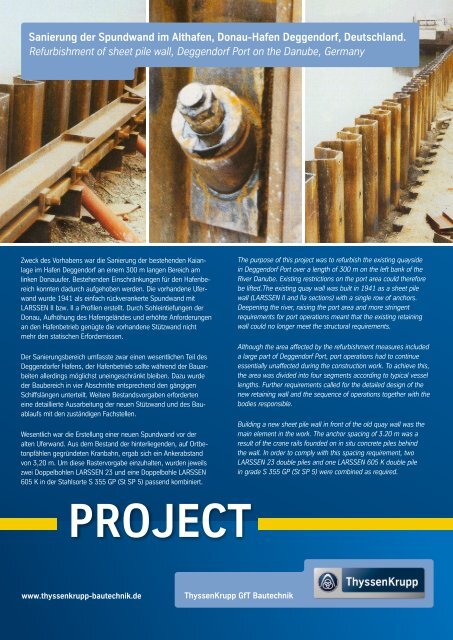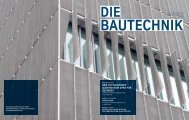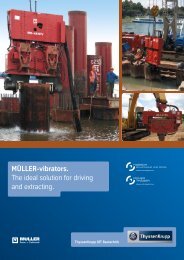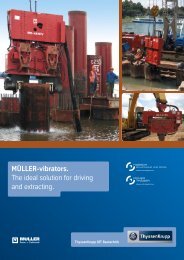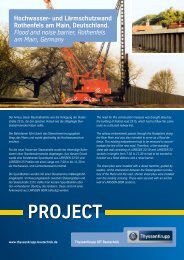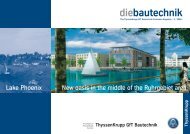PROJECT - ThyssenKrupp Bautechnik
PROJECT - ThyssenKrupp Bautechnik
PROJECT - ThyssenKrupp Bautechnik
Erfolgreiche ePaper selbst erstellen
Machen Sie aus Ihren PDF Publikationen ein blätterbares Flipbook mit unserer einzigartigen Google optimierten e-Paper Software.
Sanierung der Spundwand im Althafen, Donau-Hafen Deggendorf, Deutschland.<br />
Refurbishment of sheet pile wall, Deggendorf Port on the Danube, Germany<br />
Zweck des Vorhabens war die Sanierung der bestehenden Kaianlage<br />
im Hafen Deggendorf an einem 300 m langen Bereich am<br />
linken Donauufer. Bestehenden Einschränkungen für den Hafenbereich<br />
konnten dadurch aufgehoben werden. Die vorhandene Uferwand<br />
wurde 1941 als einfach rückverankerte Spundwand mit<br />
LARSSEN II bzw. II a Profilen erstellt. Durch Sohleintiefungen der<br />
Donau, Aufhöhung des Hafengeländes und erhöhte Anforderungen<br />
an den Hafenbetrieb genügte die vorhandene Stützwand nicht<br />
mehr den statischen Erfordernissen.<br />
Der Sanierungsbereich umfasste zwar einen wesentlichen Teil des<br />
Deggendorfer Hafens, der Hafenbetrieb sollte während der Bauarbeiten<br />
allerdings möglichst uneingeschränkt bleiben. Dazu wurde<br />
der Baubereich in vier Abschnitte entsprechend den gängigen<br />
Schiffslängen unterteilt. Weitere Bestandsvorgaben erforderten<br />
eine detaillierte Ausarbeitung der neuen Stützwand und des Bauablaufs<br />
mit den zuständigen Fachstellen.<br />
Wesentlich war die Erstellung einer neuen Spundwand vor der<br />
alten Uferwand. Aus dem Bestand der hinterliegenden, auf Ortbetonpfählen<br />
gegründeten Kranbahn, ergab sich ein Ankerabstand<br />
von 3,20 m. Um diese Rastervorgabe einzuhalten, wurden jeweils<br />
zwei Doppelbohlen LARSSEN 23 und eine Doppelbohle LARSSEN<br />
605 K in der Stahlsorte S 355 GP (St SP 5) passend kombiniert.<br />
<strong>PROJECT</strong><br />
www.thyssenkrupp-bautechnik.de<br />
The purpose of this project was to refurbish the existing quayside<br />
in Deggendorf Port over a length of 300 m on the left bank of the<br />
River Danube. Existing restrictions on the port area could therefore<br />
be lifted.The existing quay wall was built in 1941 as a sheet pile<br />
wall (LARSSEN II and IIa sections) with a single row of anchors.<br />
Deepening the river, raising the port area and more stringent<br />
requirements for port operations meant that the existing retaining<br />
wall could no longer meet the structural requirements.<br />
Although the area affected by the refurbishment measures included<br />
a large part of Deggendorf Port, port operations had to continue<br />
essentially unaffected during the construction work. To achieve this,<br />
the area was divided into four segments according to typical vessel<br />
lengths. Further requirements called for the detailed design of the<br />
new retaining wall and the sequence of operations together with the<br />
bodies responsible.<br />
Building a new sheet pile wall in front of the old quay wall was the<br />
main element in the work. The anchor spacing of 3.20 m was a<br />
result of the crane rails founded on in situ concrete piles behind<br />
the wall. In order to comply with this spacing requirement, two<br />
LARSSEN 23 double piles and one LARSSEN 605 K double pile<br />
in grade S 355 GP (St SP 5) were combined as required.<br />
<strong>ThyssenKrupp</strong> GfT <strong>Bautechnik</strong>
313,00<br />
312,15<br />
Vorteil der Profile: Sie haben eine einheitliche Wandhöhe und vergleichbare<br />
Widerstandsmomente. Unter Berücksichtigung von<br />
1,00 m Kolkzuschlag, wurden die gestaffelten Spundbohlen mit<br />
einer Länge von 11,50 bzw. 12,50 m für 50% Einspanngrad<br />
bemessen. Die Einbindelange betrug 4,00 m unter Flusssohle.<br />
Durch schlagende Rammung wurde die Einbindetiefe in den Gneiszersatz<br />
erreicht. Die Unterkante der Bohlen reicht überwiegend bis<br />
in den undurchlässigen Tertiär (sandiger Ton). Um eine größtmögliche<br />
Korrespondenz zwischen Donauwasserstand und Grundwasserstand<br />
zu ermöglichen, wurden zusätzlich zur Staffelung noch um<br />
ca. 2,00 m kürzere Doppelbohlen im Abstand von 15 m eingebracht,<br />
die im gut durchlässigen Quartär (sandiger Kies) enden.<br />
Eine temporäre Vorschüttung im Fluss diente als Arbeitsbühne für<br />
das Bohrgerät. Dadurch konnte eine Rückverankerung durch Bohrverpresspfähle<br />
als Schlaffanker mit doppeltem Korrosionsschutz mit<br />
GEWI-Stahl im Durchmesser 63,5 mm realisiert werden. Die Anker<br />
sind bis zu 27 m lang und nehmen Zugkräfte bis zu 900 kN auf.<br />
Die Gesamttonnage an Spundbohlen im Sanierungsbereich betrug<br />
ca. 600 t.<br />
Bauherr:<br />
Planung und Statik:<br />
Bauausführung:<br />
Baujahr:<br />
310,15 Donau - Danube<br />
bestehende Spundwand LARSSEN<br />
existing sheet pile wall<br />
Detail<br />
neue Spundwand - new sheet pile wall<br />
LARSSEN 605K/LARSSEN 23<br />
vorhandene Hafensohle<br />
existing port bottom<br />
305,50<br />
304,50<br />
300,50<br />
Berechnungssohle<br />
design bed<br />
Zweckverband Donau-Hafen Deggendorf<br />
Ing.-Büro Jung, Deggendorf<br />
Bilfinger + Berger Bau AG, NL Passau<br />
1997/1998<br />
<strong>PROJECT</strong><br />
www.thyssenkrupp-bautechnik.de<br />
Kolksicherung<br />
scour protection<br />
Querschnitt: Kaianlage im Bereich 0 + 132 m<br />
Section through quayside in area 0 + 132 m<br />
Kranbahngründung<br />
craneway foundation<br />
Ladegleis<br />
loading platform<br />
35° - 45°<br />
Entwässerungsrinne<br />
drainage channel<br />
Rundstahlanker 60 mm<br />
round steel tie rod<br />
Ø Ø 60 mm<br />
Bohrpfahl 800 mm<br />
bored pile Ø Ø 800 mm<br />
Bohrpfahl 750 mm, Neigung 5:1<br />
bored pile Ø Ø 800 mm, rake 5:1<br />
Verpreßpfahl<br />
injection anchor<br />
Detail: Ankerkopf - anchor head<br />
Spundwand LARSSEN 605K<br />
sheet piling LARSSEN 23<br />
Grundplatte mit Keilstück<br />
anchor plate<br />
with wedge<br />
The advantages of these sections are that they have the same depth<br />
and comparable section moduli. Taking into account a 1.00 m scouring<br />
allowance, the sheet piles in lengths of 11.50 and 12.50 m in a<br />
staggered arrangement were designed for a 50% degree of fixity.<br />
The embedment length was 4.00 m below the bed of the river.<br />
Impact driving was used to achieve this embedment depth in the<br />
decomposed gneiss. The bottom edges of most piles extend into<br />
the impermeable tertiary sandy clay. In order to achieve maximum<br />
correspondence between the level of the Danube and the level of<br />
the groundwater, the staggered piling was augmented by the installation<br />
of double piles approx. 2.00 m shorter at 15 m intervals, which<br />
terminate in the easily permeable quaternary sandy gravel.Temporary<br />
backfilling in the river provided a working platform for the drilling<br />
plant. This also enabled the wall to be anchored with (non-pre-<br />
stressed) grouted anchors with duplex corrosion protection on the<br />
63.5 mm dia. GEWI bars. The anchors are up to 27 m long and<br />
accommodate tensile forces of up to 900 kN.<br />
The total weight of sheet piles in the refurbishment zone was approx.<br />
600 t.<br />
Client:<br />
Planning &<br />
structural analysis:<br />
Contractor:<br />
Completed:<br />
<strong>ThyssenKrupp</strong> GfT <strong>Bautechnik</strong><br />
Gurtung ][400<br />
waling<br />
Bohrloch<br />
drilled hole<br />
Verpreßpfahl<br />
injection<br />
anchor<br />
Auffüllung<br />
fill<br />
Kies, Sand<br />
gravel, sand<br />
Kies, Sand, Schluff<br />
gravel, sand, silt<br />
Sand, Schluff<br />
sand, silt<br />
Kies, Sand, Schluff<br />
gravel, sand, silt<br />
Sand, Schluff<br />
(Gneiszersatz)<br />
sand, silt<br />
(decomposed gneiss)<br />
Zweckverband Donau-Hafen Deggendorf<br />
Ing.-Büro Jung, Deggendorf<br />
Bilfinger + Berger Bau AG, Passau branch<br />
1997/98


